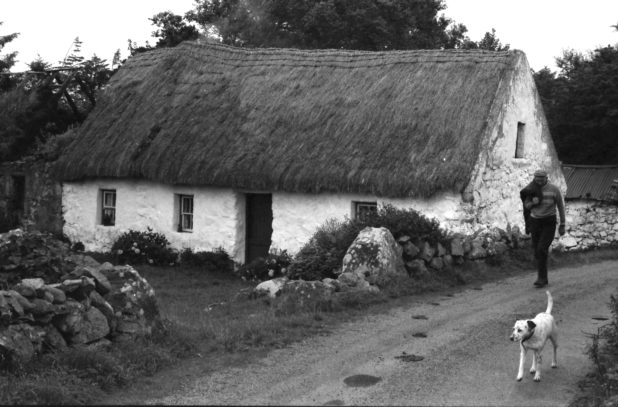One such answer could be found in the Japanese term Wabi Sabi . It has a number of meanings and applications, but mainly Wabi Sabi promotes a view of the world which seems to celebrate the beauty of imperfection. In art it is defined by impermanence, imperfection and incompleteness. Characteristics of Wabi Sabi art include things like modesty, roughness and asymmetry, often integrating the environment of natural objects and processes like rivers and rocks into design. More and more it is becoming a trend in architecture as a reaction against modernity. Yet the true origin of this Japanese philosophy has long roots in that nations past.
Originally the word Wabi simply meant poverty, while Sabi meant loneliness or solitude. In fact the use of Wabi was used to describe those hermits who went into the remotest regions in search of peace and solitude. Japanese poetry is full of such examples. Take this short work by poet Li Po:
Birds have vanished into deep skies.
A last cloud drifts away, into idleness.
Inexhaustible, this Mountain and I
gaze at each other, until it alone is remaining.
These words get across the impermanence and transitory nature of life. Li Po has found a temporary intimacy with nature. It’s the same kind of moment captured by writers like William Wordsworth in his famous poem about Daffodils:
For oft, when on my couch I lie
In vacant or in pensive mood,
They flash upon that inward eye
Which is the bliss of solitude;
And then my heart with pleasure fills,
And dances with the daffodils.

In some ways Wabi Sabi is about being alone; appreciating nature in a moment of clarity, but it also has roots in everyday practices. The Japanese tea ceremony, (yes, perhaps us Irish people can also appreciate that tea is ceremonial and essential) was originally a ceremony of luxury and ornateness. However sometime around the 16th century, tea-makers began to instead prize those jugs and tea-cups which had a more rustic appearance. This change co-coincided with the emergence of the Wabi-Sabi philosophy.
At a time when Buddhist temples were under funded, when monks had to entertain guests, many had to resort to natural objects such as bamboo and wildflowers in place of more ornate items. In these rustic objects they found different hues of colour. They found imperfections and nuances in a bamboo vase, or the decaying of a knot in old timbre, these came to symbolise a way of life, providing vehicles for contemplation.
That is not to say that the Wabi Sabi way is to strive for mediocrity. There is an expression the Japanese have which says that those who make things of inferior quality are worse than thieves, because their creations don’t last or provide true satisfaction. I’m thinking of the modern washing machine or kettle you have to replace every year.
But Again, if we were to relate such a philosophy as Wabi Sabi to our own experience, it puts in mind that image of the Irish thatch cottage or the traditional Irish kitchen which people value to this day in our own country. Far from these old dwellings being unchanging, perhaps what we most value in them is in fact their weathering of storms; how they are able to exist amid the harsh winds coming in from the sea, their walls and surfaces marred but still standing. In times of uncertainty they are a reminder that though there are things we cannot control there is also endurance.

Often the intention with modern architecture has been to block out nature out rather than to integrate it, but perhaps this view is changing. Still, it goes a long way to be mindful man of the high-concepts we see in our cities can be lost on citizens who feel alienated by the slickness of the designs which stand apart from the old stone bridges, the historical monuments and the buildings our Grandparents grew up in. Some modern buildings and art pieces are so meticulously created, they cease to inspire any wonder or contemplation at all. This is why many people are looking for a lived-in quality to the spaces they inhabit, and why Wabi Sabi is more popular than ever; Jack Dorsey , creator of Twitter credits the philosophy with helping in his creative process, and there are many others like him following suit.
None of this is to say Wabi-Sabi is a celebration of the ugly or shoddily made, only that it recognises incompleteness and imperfection as having novelty, and of even being a necessary part of every great work. Consider how the“leaning tower of Pizza” has captured our fascination for centuries, or the fact that though much of Leonardo Da Vinci’s work is incomplete and unfinished, he is still hailed as perhaps the greatest artist of his time. It makes you wonder if there may not be something in the idea of impermanence and incompleteness after all.
On a deeper level thinking of things like Wabi Sabi may be most useful in terms of trying to accept life, , people and relationships as they are and not as projects to be worked upon. Particularly when it come to ourselves it’s good to stop being a perfectionist. It’s only then that maybe you find the real peculiar treasure therein. That, or you may become a wandering monk lost in the forest. Either way you will be able to say you have truly found what Wabi Sabi means!









